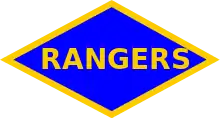5th Ranger Battalion
The 5th Ranger Infantry Battalion was a Ranger battalion activated during World War II on 1 September 1943 at Camp Forrest, Tennessee. By this time, while in maneuvers on the United States, they were commanded by the Major Owen Carter. Later, when they moved to England, they were commanded by Major (later Lieutenant Colonel) Max Schneider,[1] former executive officer of the 4th Ranger Battalion, who led the 5th Rangers as part of the Provisional Ranger Group commanded by Colonel James Earl Rudder.
| 5th Ranger Infantry Battalion | |
|---|---|
 Shoulder sleeve patch of the 5th Ranger Battalion | |
| Active | September 1, 1943 – October 22, 1945 |
| Country | |
| Branch | |
| Type | Light infantry Special operations force |
| Role | Direct action Raiding Reconnaissance Special operations |
| Engagements | World War II |
History
World War II
The 5th Ranger Battalion was activated on 1 September 1943 at Camp Forrest, Tennessee. During the Battle of Normandy, the battalion landed on Omaha Beach along with companies A, B and C of the 2nd Ranger Battalion, where elements of the 116th Infantry Regiment of the 29th Infantry Division were pinned down by murderous machine gun fire and mortars from the heights above. It was there that the situation was so critical that General Omar Bradley was seriously considering abandoning the beachhead, instead of sending more men to die. And it was then and there that General Norman Cota, Assistant Division Commander of the 29th Infantry Division, gave the now famous order that has become the motto of the 75th Ranger Regiment: "Rangers, Lead The Way!"[2]
The 5th Battalion Rangers broke across the seawall and barbed wire entanglements, and up the pillbox-rimmed heights under intense enemy machine gun and mortar fire and with A, B and C Companies of the 2nd Ranger Battalion and elements of the 116th Infantry Regiment, advanced four miles (6 km) to the key town of Vierville-sur-Mer, thus opening the breach for supporting troops to follow up and expand the beachhead. Meanwhile, D, E and F Company of the 2nd Battalion, due to rough seas, landed west of the Vierville draw and suffered 50 percent casualties during the landing, but still scaled a 90-foot (27 m) cliff using ropes and bayonets to knock out a formidable enemy position that was sweeping the beach with deadly fire.
The 5th Battalion with elements of the 116th Regiment finally linked up with the beleaguered D,E and F companies of 2nd Battalion on D+3, although Lieutenant Charles Parker of A Company, 5th Battalion, had penetrated deep behind enemy lines on D-Day and reached the 2nd Battalion with 20 prisoners. Later, with the 2nd Battalion, the unit distinguished itself in the hard-fought Battle for Brest. Under the leadership of Lieutenant Colonel Richard Sullivan, the 5th Ranger Battalion took part in the Battle of Huertgen Forest, Battle of the Bulge and other tough battles throughout central Europe, earning two Distinguished Unit Citations and the French Croix de Guerre.
Deactivation
The outfit was deactivated 22 October 1945 at Camp Myles Standish, Massachusetts.[3]
In 1986, the still deactivated 5th Ranger Battalion was consolidated with units of the 75th Infantry Regiment (Ranger) during its reorganization into the 75th Ranger Regiment.[4]
Battle honors
Battle honors received for actions in the invasion of France:[5]
- Citation approved by the Commanding General, First U.S. Army, in the name of the President of the United States for actions as leading assault unit on the beach at H-Hour on D-Day in the invasion of France.
- Commendation from Major General C. H. Gerhardt for participation in the capture of the City of Brest, Fort Pt. Minon and Fort De Mengaht.
- Commendation from Lieutenant General William H. Simpson in the capture of Brest.
References
- Glassman, Henry S., "Lead the Way, Rangers", History of the Fifth Ranger Battalion, Page 13.
- Sterne, Gary (2014). The Cover-up at Omaha Beach. Skyhorse Publishing. pp. 53–55. ISBN 9781629143279.
- Rottman, Gordon L. (1987) U.S. Army Rangers & LRRP Units 1942–87, Page 15.
- "Lineage and Honors 75th RANGER REGIMENT". United States Army Center of Military History. 27 April 2017. Archived from the original on 21 July 2022. Retrieved 11 October 2022.
- Glassman, Henry S., "Lead the Way, Rangers", History of the Fifth Ranger Battalion.
